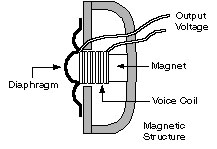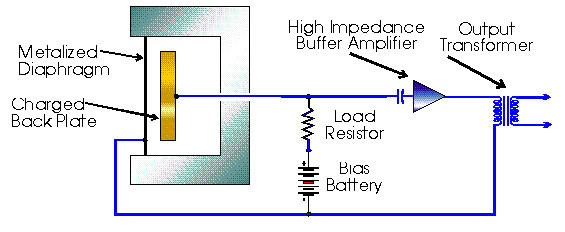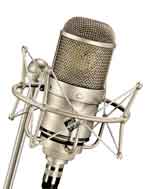Contents
What’s the best kind of microphone to use? And what’s the difference between the different types? We explain how to choose the best mic for you.
Like many aspects of recording, choosing a microphone is as much black art as science. We can, however, greatly simplify the choice by looking at the two main aspects of a mic – microphone type and microphone pickup patterns.
There are two main types of microphone (although there are other derivations and variations which we’ll touch on) and three main responses or pickup patterns. We’ll look at the microphone types first.
How microphones work
Most mics work in essentially the same way. They have within them some light material called a diaphragm. When sound waves hit the diaphragm it vibrates generating an electrical current (the audio signal in electronic format) which is then fed to an amplifier, mixer or recording device. The main difference between microphone types is the diaphragm and how it generates electrical signals.
Dynamic mics




They are good at capturing loud, up-front sounds – another plus for live performance – but not so good at capturing quiet sounds and high frequencies over 15kHz. One good thing about dynamic mics is that they’re relatively inexpensive. Classic vocalist mics include the Shure SM57 and SM58.
Condenser mics
Condenser or capacitor microphones generally have a much lighter diaphragm and work on a capacitor principle (which is why they are also known as capacitor mics). In a capacitor, an electrical charge is stored between two plates. If the distance between the plates is changed, then the charge changes too.


The diaphragm is positioned in front of a solid back-plate and either may be electrically charged. When sound waves hit the diaphragm, it moves relative to the bac

Because the diaphragm is thin, it responds better to high frequencies, up to 20kHz, and quiet sounds and it produces a more natural recording. While this would seem to be desirable, some vocals such as rock and punchy stuff can benefit from the inadequacies of a dynamic mic. However, you will often find condensers in studios, even for recording vocals, because they are more versatile and responsive.
Tech terms
Phantom power
The supply of power from the ground cable of an XLR connector. The voltage can vary but it’s typically 48 volts. The power can come from a connection to a mixer or a dedicated phantom power box.
Pre-amp
An amplifier built into some mics that boosts the signal level, is often necessary due to the low signal level generated by mics.
Proximity effect
Some mics enhance the low frequencies of a sound source that is close to the diaphragm. This is the proximity effect. Knowledgeable vocalists and speakers can make use of this to good effect but it can cause problems with inexperienced mic users.
Condenser mics need a power supply to power the pre-amp. This can be a battery inserted into the mic but more commonly phantom power is used where available, generally from a mixer.
The downside to condensers is that they are less robust and more expensive than dynamic mics although recent improvements in microphone technology have improved robustness and reduced prices, too. Popular condensers include the Neumann U47 and the AKG 414.
Back-electret mics
The back-electret is a condenser microphone but the back-plate features an electret material (hence the name) which is permanently charged. This electric charge will eventually wear off, although manufacturers typically claim a life expectancy of 20-25 years. Like condensers, back-electrets also need power.
These mics offer better performance than a dynamic but they are more robust than a condenser so you get close to a condenser performance with greater robustness. Their other major attraction is that they are cheaper than condensers.
Other microphone types
There are several other mic types that deserve a mention. The tube microphone is a condenser with valves that offers ‘valve warmth’ but that must be weighed against the cost, fragility and increased background noise with low-level signals.
The ribbon microphone is now quite rare although you may find them in high-end studios. They are a form of dynamic mic using a ribbon in front of a metal plate. They are very sensitive and are therefore very good for quiet sounds and excel at close-micing. They are very fragile and have largely been superseded by condensers except for specialist situations.
So-called bass mics are dynamics with large diaphragms. They are very robust and used with sources that generate loud sounds such as inside a bass drum but they have poor high-frequency response.
Pickup patterns
The other aspect of a microphone you need to consider is its response or pickup pattern. Some people think that if you point a mic towards something, that’s all it records. Not so. There are three common response patterns plus two variations.




![]()
![]()


![]()
![]()
Putting it all together
Ideally, you will have separate mics for different purposes such as recording vocals, acoustic guitars, micing drums and so on. In practice you may not have the luxury or the budget so here are a few guidelines to help, but do bear in mind that this is where personal preferences and the black arts come to the fore.
In a studio, the condenser is the most versatile and one with a cardioid response should serve as a good all-rounder. Vocals can benefit from an omni-directional mic providing there are no sounds in front of the singer. Having said that, some vocalists prefer the response of a dynamic mic because it makes them sound better.
For live use with rock material or vocals that need to be punchy, up-front and in-yer-face, a dynamic mic is the answer. If you need the mic to double in the studio then consider a back-electret while saving for separate condenser and dynamic mics.
Recommending a single mic to record a range of acoustic instruments is difficult as different mics afford different recording techniques. An omni-directional mic can be dangled or placed on a stand in front of an instrument. Condensers would usually be recommended although dynamic mics are commonly used for micing drum kits. The placement of mics for recording instruments, however, is beyond the scope of this short feature.
If you can only afford one mic and want a good all-rounder, a back-electret is a good choice.
If you get the opportunity to try different mics, you may be surprised at the difference they make to the recording and there’s nothing wrong in preferring a dynamic to a condenser for vocals or a cardioid to an omni if you prefer the sound and can work the proximity effect. That’s where art overtakes science in the world of music.
For more info…
Many microphone manufacturers’ websites include a lot of useful information about microphones. The Sure site is a mine of essential information:
Buyer’s Guide
How Tos, Tips & Tricks









